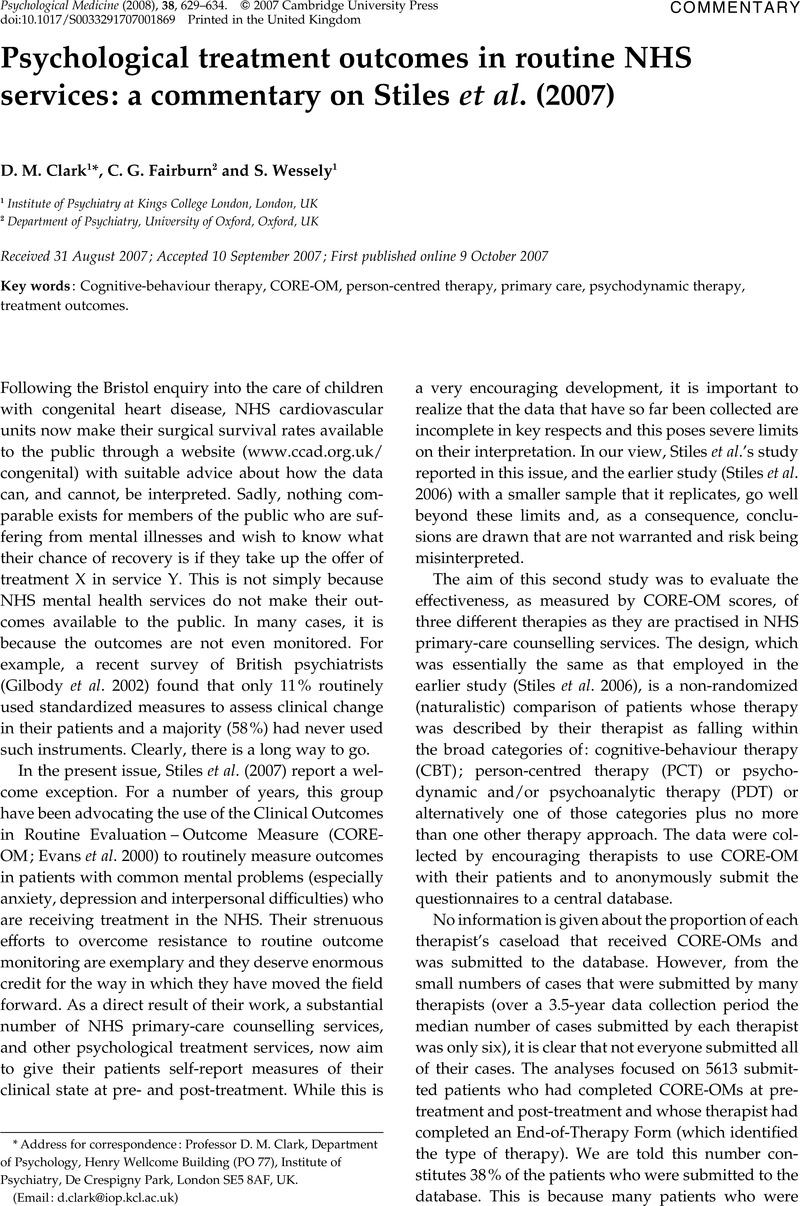Crossref Citations
This article has been cited by the following publications. This list is generated based on data provided by Crossref.
STILES, W. B.
BARKHAM, M.
MELLOR-CLARK, J.
and
CONNELL, J.
2008.
Correspondence.
Psychological Medicine,
Vol. 38,
Issue. 6,
p.
905.
Middleton, Hugh
2008.
Whither DSM and ICD, Chapter V?.
Mental Health Review Journal,
Vol. 13,
Issue. 4,
p.
4.
Barkham, Michael.
and
Parry, Glenys.
2008.
Balancing rigour and relevance in guideline development for depression: The case for comprehensive cohort studies.
Psychology and Psychotherapy: Theory, Research and Practice,
Vol. 81,
Issue. 4,
p.
399.
Gibbard, Isabel
and
Hanley, Terry
2008.
A five‐year evaluation of the effectiveness of person‐centred counselling in routine clinical practice in primary care.
Counselling and Psychotherapy Research,
Vol. 8,
Issue. 4,
p.
215.
Clark, David M.
Layard, Richard
Smithies, Rachel
Richards, David A.
Suckling, Rupert
and
Wright, Benjamin
2009.
Improving access to psychological therapy: Initial evaluation of two UK demonstration sites.
Behaviour Research and Therapy,
Vol. 47,
Issue. 11,
p.
910.
Miller, Ashley
and
Shepherd, Melanie
2009.
Therapists’ and clients’ views regarding outcome data collection.
Clinical Psychology Forum,
Vol. 1,
Issue. 200,
p.
34.
Barber, Jacques P.
2009.
Toward a working through of some core conflicts in psychotherapy research.
Psychotherapy Research,
Vol. 19,
Issue. 1,
p.
1.
Richards, David A.
and
Suckling, Rupert
2009.
Improving access to psychological therapies: Phase IV prospective cohort study.
British Journal of Clinical Psychology,
Vol. 48,
Issue. 4,
p.
377.
Barkham, Michael
Stiles, William B.
Lambert, Michael J.
and
Mellor‐Clark, John
2010.
Developing and Delivering Practice‐Based Evidence.
p.
21.
Barkham, Michael
Hardy, Gillian E.
and
Mellor‐Clark, John
2010.
Developing and Delivering Practice‐Based Evidence.
p.
327.
Wampold, Bruce E.
Imel, Zac E.
Laska, Kevin M.
Benish, Steven
Miller, Scott D.
Flűckiger, Christoph
Del Re, Aaron C.
Baardseth, Timothy P.
and
Budge, Stephanie
2010.
Determining what works in the treatment of PTSD.
Clinical Psychology Review,
Vol. 30,
Issue. 8,
p.
923.
Cahill, Jane.
Barkham, Michael.
and
Stiles, William B.
2010.
Systematic review of practice‐based research on psychological therapies in routine clinic settings.
British Journal of Clinical Psychology,
Vol. 49,
Issue. 4,
p.
421.
Parry, Glenys
Castonguay, Louis G.
Borkovec, Tom D.
and
Wolf, Abraham W.
2010.
Developing and Delivering Practice‐Based Evidence.
p.
311.
Wampold, Bruce E.
Budge, Stephanie L.
Laska, Kevin M.
Del Re, A.C.
Baardseth, Timothy P.
Flűckiger, Christoph
Minami, Takuya
Kivlighan, D. Martin
and
Gunn, Wade
2011.
Evidence-based treatments for depression and anxiety versus treatment-as-usual: A meta-analysis of direct comparisons.
Clinical Psychology Review,
Vol. 31,
Issue. 8,
p.
1304.
Hanley, Terry
Sefi, Aaron
and
Lennie, Clare
2011.
Practice‐based evidence in school‐based counselling.
Counselling and Psychotherapy Research,
Vol. 11,
Issue. 4,
p.
300.
Andrews, William
Twigg, Elspeth
Minami, Takuya
and
Johnson, Gina
2011.
Piloting a practice research network: A 12‐month evaluation of the Human Givens approach in primary care at a general medical practice.
Psychology and Psychotherapy: Theory, Research and Practice,
Vol. 84,
Issue. 4,
p.
389.
de Beurs, E.
den Hollander‐Gijsman, M. E.
van Rood, Y. R.
van der Wee, N. J. A.
Giltay, E. J.
van Noorden, M. S.
van der Lem, R.
van Fenema, E.
and
Zitman, F. G.
2011.
Routine outcome monitoring in the Netherlands: practical experiences with a web‐based strategy for the assessment of treatment outcome in clinical practice.
Clinical Psychology & Psychotherapy,
Vol. 18,
Issue. 1,
p.
1.
Wilson, G. Terence
2011.
IAAP Handbook of Applied Psychology.
p.
28.
WOLPERT, MIRANDA
FORD, TAMSIN
TRUSTAM, EMMA
LAW, DUNCAN
DEIGHTON, JESSICA
FLANNERY, HALINA
and
FUGARD, REW J. B.
2012.
Patient-reported outcomes in child and adolescent mental health services (CAMHS): Use of idiographic and standardized measures.
Journal of Mental Health,
Vol. 21,
Issue. 2,
p.
165.
2012.
Maximising the Benefits of Psychotherapy.
p.
1.



